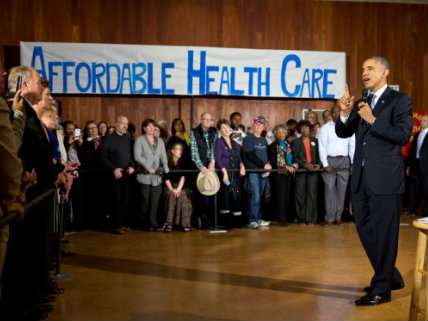What's Really Going On With Obamacare Insurance Premiums?

You might have seen headlines recently trumpeting Obamacare's success at restraining health insurance premiums next year. One analysis, relying on early rate filings in major urban areas, actually found a slight drop in "benchmark" plans—a particular category of mid-priced plans sold through the exchanges.
But the story with premiums is, at minimum, more complicated than that. A new report in The New York Times, which digs through early rate filing data, does a good job of teasing out the complexities.
For one thing, as the Times notes, it's not all that helpful to just look at average prices, because "individual consumers don't buy the average plan. And the federal government doesn't pay for the average plan." And when you look beyond the averages, the premium changes we're seeing so far don't look quite so rosy, especially for those who stick with their current plans. "In many places premiums are going up by double-digit percentages within many of the most popular plans," the Times reports.
Now, it's true that in one sense, we're seeing a remarkable restraint in premium growth: Prices for the cheapest plans in the law's "silver" tier—the middle of the plan hierarchy, which must cover 70 percent of average costs—are expected to drop in some states, and rise just 1 percent overall.
But the cheapest silver plan last year is not necessarily the same as the cheapest silver plan this year. So if you're already in the system, and you want to keep your premium from rising, that means you'll probably have to switch to a different plan, with a different payment configurations and a different network providers.
On the other hand, if you're on the cheapest plan from last year, and you want to stay in your plan—or if you bought through a federally run exchange and decide to accept the auto-renewal system that the administration has set up—then you're probably in for big price hikes. "Those prices are going up almost everywhere," the Times reports. "In some cases, they have increased by more than 10 percent. The average increase is 8.4 percent."
So you can keep your premium—or you can keep your plan. But in many cases, you can't keep both.
There are potential upsides here. In theory, it could teach people buying through the exchanges to shop around more frequently, which could create a more cost-effective, competitive health insurance ecosystem. The fact that the low-end of the silver tier is holding steady suggests that insurers may, in fact, be looking to compete with each other on price. Most of the inexpensive plans next year are new entrants, or are plans with fewer members, looking to price low in order to gain market share.
But how long can that go on? If low-prices exist only as teaser rates, designed to lure in customers whose premiums will be hiked later on, then what we're really seeing may not be meaningful cost-restraint so much as artificially low prices that aren't sustainable over time.
And to some extent, all the premium prices we're seeing right now are artificial, or at least experimental, because they are built on the expectation of a significant federal subsidy in the event of unexpectedly high claims costs. Obamacare's "risk corridors" program—often referred to as its insurer bailout—runs through 2016, and it allows insurers to experiment with potentially unsustainable low pricing. Insurance industry consultant Bob Laszewski recently wrote that he's heard "reports of actuarial consultants going around to the plans that failed to gain substantial market share suggesting they lower their rates in order to grab market share because they have nothing to lose" thanks to the way Obamacare covers insurer losses.
As Laszewski also notes, there's not much in the way of claims data so far, so insurers don't really have good information about the expected costs of the exchange population, which means the rates they are setting are heavy on guess work.
The big picture here is that it's hard to tell what's going on with Obamacare premiums. Prices on popular plans are pretty clearly going up, but there does seem to be some effort to compete on price, at least for now. But how long will that last? And how big a success is it really if it requires hefty federal subsidies for both individuals and insurers?


Show Comments (74)